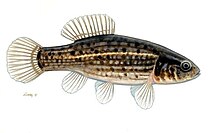Umbridae
| Umbridae | |
|---|---|

| |
| Scientific classification | |
| Kingdom: | Animalia |
| Phylum: | Chordata |
| Class: | Actinopterygii |
| Order: | Esociformes |
| Family: | Umbridae |
| Genera | |
|
† | |
Umbridae is a family of fish in the order Esociformes, which contains pike, pickerel, and mudminnows. The single living genus, Umbra, occupies weed-choked freshwater habitats in eastern North America and eastern Europe. While the family traditionally contained the genera Umbra, Novumbra, and Dallia, recent genetic and paleontological research have recovered this grouping as paraphyletic, with Novumbra and Dallia being moved to the family Esocidae.
Distribution[]
Umbridae contains three extant species, all within the genus Umbra: Umbra pygmaea, Umbra limi, and Umbra krameri. U. pygmaea can be found across the eastern United States and southeastern Canada. U. limi ranges throughout the Great Lakes region and Mississippi River basin of North America. U. krameri can be found in the Danube and Dniester River basins of Europe.[1] Umbra spp. are most commonly found in the Atlantic coast regions of North America, along the marshy, low-oxygen areas of the Mississippi River, and in similar environments in Europe. All fossil specimens have been recovered from Europe, occupying similar niches to extant species.[citation needed]
Behavior[]
Like all esociformes, the extant species of Umbridae are sight-based ambush predators, with umbrids occupying the niche of a bottom-feeding generalist. Diet changes based on seasonal availability, however primarily consists of invertebrates in all extant species. Detritus is also a major stomach content throughout the year as reported in U. pygmaea.[2] During winter months, U. limi has been observed hunting fish.[3] Cannibalism has been observed in at least U. pygmaea.[2]
Umbrids, like Dallia and Novumbra, have an extreme tolerance for hypoxic conditions. Umbra has been observed surviving under ice in particularly cold winters, and has the ability to survive desiccation by burrowing tail-first into mud in times of drought.[4] Umbra can breathe atmospheric air using a modified gas bladder to absorb oxygen.[5]
Relationships[]
Umbrids have been present in Europe with fossils of the primitive genus dating back to the Paleocene. Following Boltyshia, fossils of , another primitive genus, entered the known fossil record in the Middle Eocene. In contrast to Boltyshia, Palaeoesox had a much longer stratigraphical range, surviving until possibly the Late Miocene based on otoliths assigned to the genus, though at least the Middle Miocene based on the presence of body fossils. Palaeoesox overlaps its temporal range with Umbra; the two species coexisted within Europe for at least 10 million years, as fossils of the earliest members of the genus Umbra have been recovered during the latest Oligocene. A single species has been assigned to the genus , which was recovered in fossil beds dating to the late Oligocene.[6]
Genetic work has reported that separation of the European and North American species in the genus Umbra occurred roughly at the end of the Late Cretaceous and earliest half of the Paleogene, at the date of 60.57 million years ago with the 95% highest probability density of 39.57-81.75. The cause of the split in the genus coincides with the separation of the European and North American continents.[7]
One of the basalmost genera, Palaeoesox, preserves depressible teeth similar to those of Esox. This trait may have been present in the last common ancestor of Esocidae before the umbrid/esocid split, and is lost today in Umbra, Dallia, and Novumbra.[8]
The following cladogram illustrates the relationship between umbrid genera.
| Esociformes |
| |||||||||||||||||||||||||||
References[]
- ^ Kottelat, M., 1997. European freshwater fishes. Biologia 52, Suppl. 5:1-271.
- ^ a b Panek, Frank M.; Weis, Judith S. (March 2013). "Diet of the Eastern Mudminnow (Umbra pygmaea DeKay) from Two Geographically Distinct Populations within the North American Native Range". Northeastern Naturalist. 20 (1): 37–48. doi:10.1656/045.020.0103. ISSN 1092-6194.
- ^ Jenkins, Jennifer R.; Miller, Brian A. (July 2007). "Shoaling Behavior in the Central Mudminnow (Umbra limi)". The American Midland Naturalist. 158 (1): 226–232. doi:10.1674/0003-0031(2007)158[226:SBITCM]2.0.CO;2. ISSN 0003-0031.
- ^ Phillips, Gary L.; Schmid, William D.; Underhill, James C. (1982-06-05). Fishes of the Minnesota Region. University of Minnesota Press. ISBN 978-0-8166-8169-3.
- ^ Currie, S.; Bagatto, B.; DeMille, M.; Learner, A.; LeBlanc, D.; Marks, C.; Ong, K.; Parker, J.; Templeman, N.; Tufts, B. L.; Wright, P. A. (January 2010). "Metabolism, nitrogen excretion, and heat shock proteins in the central mudminnow (Umbra limi), a facultative air-breathing fish living in a variable environment". Canadian Journal of Zoology. 88 (1): 43–58. doi:10.1139/z09-117. ISSN 0008-4301.
- ^ Gaudant, Jean (2012-02-01). "An attempt at the palaeontological history of the European mudminnows (Pisces, Teleostei, Umbridae)". Neues Jahrbuch für Geologie und Paläontologie - Abhandlungen: 93–109. doi:10.1127/0077-7749/2012/0214.
- ^ Marić, Saša; Stanković, David; Wanzenböck, Josef; Šanda, Radek; Erős, Tibor; Takács, Péter; Specziár, András; Sekulić, Nenad; Bănăduc, Doru; Ćaleta, Marko; Trombitsky, Ilya (May 2017). "Phylogeography and population genetics of the European mudminnow (Umbra krameri) with a time-calibrated phylogeny for the family Umbridae". Hydrobiologia. 792 (1): 151–168. doi:10.1007/s10750-016-3051-9. ISSN 0018-8158.
- ^ Wilson, Mark V. H.; Brinkman, Donald B.; Neuman, Andrew G. (September 1992). "Cretaceous Esocoidei (Teleostei): early radiation of the pikes in North American fresh waters". Journal of Paleontology. 66 (5): 839–846. doi:10.1017/S0022336000020849. ISSN 0022-3360.
- Umbridae
- Ray-finned fish families
- Esociformes